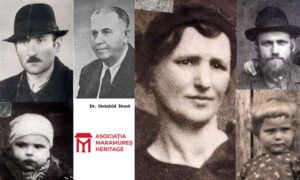Comunitatea evreiască din Vișeu de Jos
Comunitatea evreiescă din Vișeu de Jos, Maramureș/ Az alsóvisói zsidó közosség, Máramaros megye, Románia/ The Jewish community from Vișeu de Jos, Maramureș county, Romania
La recensământul din 1768 erau înscriși patru capi de familie evrei, însumând nouă persoane, în timp ce în celelalte două Vișee nu erau enumerați alți evrei. Mai mult, este aproape sigur că aici a fost prima școală pentru copii evrei din această zonă a Maramureșului.
Apogeul populației evreiești din acest sat a venit înainte de Primul Război Mondial, când populația evreiască a ajuns la 14,6% din populația generală. În anul 1930 în localitate trăiau 604 evrei și majoritatea aveau ca limba maternă idiș.
Ultimul președinte al comunității a fost Jakab Ganer, iar Fenj Maghed a fost ultimul rabin.
Comunitatea din Vișeu de Jos a fost subordonată celei din Vișeu de Sus pe toată durata ei.
În timpul Holocaustului soarta evreilor din Vișeu de Jos era aceeași cu soarta evreilor din zonă. La câteva zile după Paște toți evreii satului au fost adunați și mutați în ghetoul din Vișeu de Sus. Bărbații au mers pe jos, suferind bătăi și abuzuri, în timp ce femeile și copiii au fost transferați în ghetou cu căruța. Este oportun să remarcăm în mod pozitiv câțiva cetățeni din Vișeu de Sus care au încercat să ducă puțină mâncare în ghetou.
După război câteva zeci de evrei din Vișeu de Jos s-au întors în oraș. Aproape toți evreii au părăsit orașul la sfârșitul anilor 1950. Majoritatea au făcut aliya în Israel. Astăzi nu mai trăiesc evrei în Vișeu de Jos.
Az 1768-as összeírásban négy zsidó családfőt, összesen kilenc főt soroltak fel, míg a másik két visón más zsidót nem voltak. Továbbá szinte biztos, hogy Máramarosban itt volt az első zsidó gyerekek iskolája.
A falu zsidó lakosságának számának csúcsa az első világháború előtt érte el, amikor a zsidó lakosság elérte a teljes lakosság 14,6%-át. 1930-ban 604 zsidó élt a faluban, többségüknek a jiddis volt az anyanyelve.
A közösség utolsó elnöke Ganer Jakab, Fenj Maghed pedig az utolsó rabbi.
Alsóvisó közössége fennállásának teljes ideje alatt a felsővisói közösségnek volt alárendelve.
A Holokauszt idején az alsóvisói zsidók sorsa megegyezett a környékbeli zsidókéval. Néhány nappal az 5704-es húsvét (1944) után a falu összes zsidóját összegyűjtötték és átvitték a felsővisói gettóba. A férfiak gyalog mentek, veréstől és bántalmazástól szenvedtek, míg a nőket és a gyerekeket szekéren szállították a gettóba. Helyénvaló pozitívan megjegyezni több felsővisói nem zsidó lakost, akik megpróbáltak egy kis élelmet a gettóba szállítani.
A háború után pár alsóvisói zsidó visszatért a faluba. Az 1950-es évek végén szinte az összes zsidó elhagyta a falut. A legtöbben Izraelbe alijáztak . Ma Alsóvisón nincsenek zsidó.
In the census of 1768, four Jewish family heads were listed, totaling nine individuals, whereas no other Jews were listed in the other two Vișeu. Furthermore, it is almost certain that the first school for Jewish children in this area of Maramures was there. In 1930, 604 Jews lived in the village and most of them had Yiddish as their mother tongue.
The last president of the community was Jakab Ganer and Fenj Maghed was the last rabbi.
The pinnacle of the Jewish population of this village came before the First World War, when the Jewish population reached 14.6% of the general population.
The community of Vișeu de Jos was subordinate to that of Vișeu de Sus throughout its entire period of existence.
At the time of the Holocaust, the fate of the Jews of Vișeu de Jos was the same as the fate of the Jews of the area. A few days after Passover 5704 (1944), all the Jews of the village was gathered together and transferred to the ghetto of Vișeu de Sus. The men went on foot, suffering from beatings and abuse, whereas the women and children were transferred to the ghetto by wagon. It is appropriate to note positively several citizens of Vișeu de Sus who attempted to transfer a bit of food to the ghetto.
After the war, several Jews of Vișeu de Jos returned to the village. Almost all of the Jews left the village at the end of the 1950s. Most made aliya to Israel. Today there are no Jews in Vișeu de Jos.




Photo YadVashem




